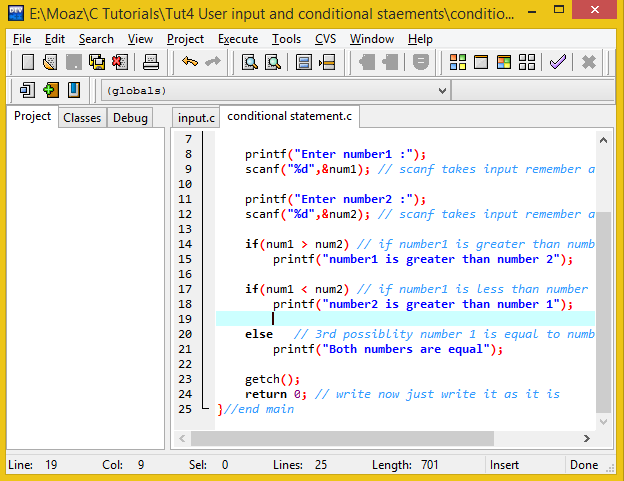How To Use Header Files In Dev C++
This code creates a file called example.txt and inserts a sentence into it in the same way we are used to do with cout, but using the file stream myfile instead. But let's go step by step: Open a file The first operation generally performed on an object of one of these classes is to associate it to a real file. C code files (with a.cpp extension) are not the only files commonly seen in C programs. The other type of file is called a header file. Header files usually have a.h extension, but you will occasionally see them with a.hpp extension or no extension at all. The primary purpose of a header file is to propagate declarations to code files. May 05, 2009 This is where header files come in. Header files allow you to make the interface (in this case, the class MyClass) visible to other.cpp files, while keeping the implementation (in this case, MyClass's member function bodies) in its own.cpp file.
-->The names of program elements such as variables, functions, classes, and so on must be declared before they can be used. For example, you can't just write x = 42 without first declaring 'x'.
The declaration tells the compiler whether the element is an int, a double, a function, a class or some other thing. Furthermore, each name must be declared (directly or indirectly) in every .cpp file in which it is used. When you compile a program, each .cpp file is compiled independently into a compilation unit. The compiler has no knowledge of what names are declared in other compilation units. That means that if you define a class or function or global variable, you must provide a declaration of that thing in each additional .cpp file that uses it. Each declaration of that thing must be exactly identical in all files. A slight inconsistency will cause errors, or unintended behavior, when the linker attempts to merge all the compilation units into a single program.
To minimize the potential for errors, C++ has adopted the convention of using header files to contain declarations. You make the declarations in a header file, then use the #include directive in every .cpp file or other header file that requires that declaration. The #include directive inserts a copy of the header file directly into the .cpp file prior to compilation.
Note
In Visual Studio 2019, the C++20 modules feature is introduced as an improvement and eventual replacement for header files. For more information, see Overview of modules in C++.
PID tuning entails establishing appropriate gain values for the process being controlled. While this can be done manually or by means of control heuristics, most modern controllers provide auto tune capabilities. However, it remains important for control professionals to understand what happens after the button in. How to tune a pid.
Example
The following example shows a common way to declare a class and then use it in a different source file. We'll start with the header file, my_class.h. It contains a class definition, but note that the definition is incomplete; the member function do_something is not defined:

Next, create an implementation file (typically with a .cpp or similar extension). We'll call the file my_class.cpp and provide a definition for the member declaration. We add an #include directive for 'my_class.h' file in order to have the my_class declaration inserted at this point in the .cpp file, and we include <iostream> to pull in the declaration for std::cout. Note that quotes are used for header files in the same directory as the source file, and angle brackets are used for standard library headers. Also, many standard library headers do not have .h or any other file extension.
In the implementation file, we can optionally use a using statement to avoid having to qualify every mention of 'my_class' or 'cout' with 'N::' or 'std::'. Don't put using statements in your header files!
Now we can use my_class in another .cpp file. We #include the header file so that the compiler pulls in the declaration. All the compiler needs to know is that my_class is a class that has a public member function called do_something().
 Bartender for Mac 2020 full offline installer setup for Mac. Bartender for Mac lets you organize your menu bar icons, by hiding them, rearranging them, show hidden items with a click or keyboard shortcut and have icons show when they update. There are many ways to configure Bartender for macOS as you wish. Give it a go and find out! Bartender lets you organize your Menu Bar Apps, by hiding them, moving them to Bartenders Bar, or displaying the full menu bar, set options to have Menu Bar Apps show in the menu bar when they are. Oct 13, 2019 To get full BarTender functionality on a Mac you will need to run Windows on the Mac computer so that you can then install BarTender in Windows. A comprehensive list of options is beyond the scope of this article, but we have included a couple suggestions. Run Windows On A Virtual Machine. Bartender 3 lets you organize your menu bar icons, by hiding them, rearranging them, show hidden items with a click or keyboard shortcut and have icons show when they update. There are many ways to configure Bartender as you wish. Give it a go and find out.
Bartender for Mac 2020 full offline installer setup for Mac. Bartender for Mac lets you organize your menu bar icons, by hiding them, rearranging them, show hidden items with a click or keyboard shortcut and have icons show when they update. There are many ways to configure Bartender for macOS as you wish. Give it a go and find out! Bartender lets you organize your Menu Bar Apps, by hiding them, moving them to Bartenders Bar, or displaying the full menu bar, set options to have Menu Bar Apps show in the menu bar when they are. Oct 13, 2019 To get full BarTender functionality on a Mac you will need to run Windows on the Mac computer so that you can then install BarTender in Windows. A comprehensive list of options is beyond the scope of this article, but we have included a couple suggestions. Run Windows On A Virtual Machine. Bartender 3 lets you organize your menu bar icons, by hiding them, rearranging them, show hidden items with a click or keyboard shortcut and have icons show when they update. There are many ways to configure Bartender as you wish. Give it a go and find out.

After the compiler finishes compiling each .cpp file into .obj files, it passes the .obj files to the linker. When the linker merges the object files it finds exactly one definition for my_class; it is in the .obj file produced for my_class.cpp, and the build succeeds.
Include guards
Typically, header files have an include guard or a #pragma once directive to ensure that they are not inserted multiple times into a single .cpp file.
What to put in a header file
Because a header file might potentially be included by multiple files, it cannot contain definitions that might produce multiple definitions of the same name. The following are not allowed, or are considered very bad practice:
How To Use Header Files In Dev C++
- built-in type definitions at namespace or global scope
- non-inline function definitions
- non-const variable definitions
- aggregate definitions
- unnamed namespaces
- using directives
Use of the using directive will not necessarily cause an error, but can potentially cause a problem because it brings the namespace into scope in every .cpp file that directly or indirectly includes that header.
Examples Of Header Files
Sample header file
C++ Header Files List
The following example shows the various kinds of declarations and definitions that are allowed in a header file: